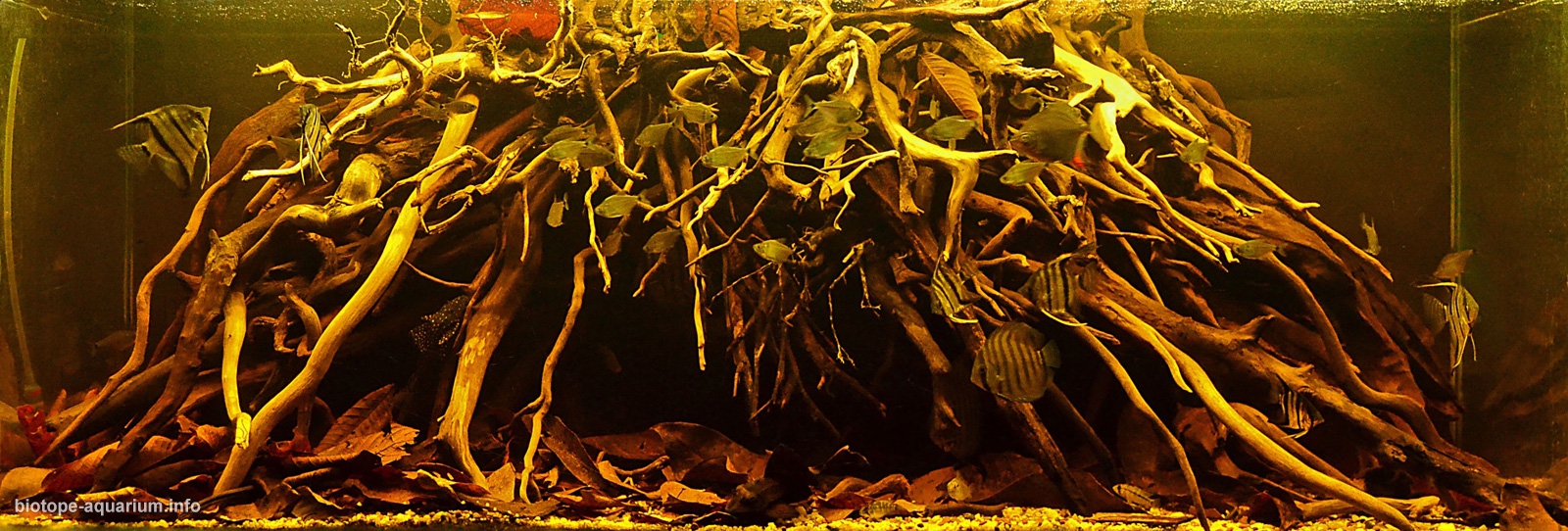Caño Tarapoto, near the mouth of the Nanay River, province of Maynas – Loreto, Peru
98th place in Biotope Aquarium Design Contest 2018
![]() Peru. Luis Alejandro Silva Paima
Peru. Luis Alejandro Silva Paima

Volume: 350 L
Dimensions: 140x50x50 cm
List of fishes: Symphysodon aequifasciatus, Pterophyllum scalare, Myloplus rubripinnis, Rineloricaria lanceolata, Hyphessobrycon sp., Apistogramma bitaeniata
List of plants: N/A
Description of decorations: White sand, gravel, driftwood, dry leaves.
Description of equipment: Two led 32W 6000K, recirculating filter SOBO AC 220-240V 50/60, 15W, air pump.
Water parameters: 27°C, pH is 6.
INFORMATION ABOUT BIOTOPE
Description of the area surrounding the biotope: Caño Tarapoto is one of the many tributaries of the Nanay River with black water, it is home to a great variety of species of ornamental and edible fish, which is used in the villages that are on its banks. Caño Tarapoto is the ideal habitat for cichlids like angelfishes, apistogrammas and the impressive discus fish, as well as plecos, tetras, catfishes, etc.
Description of the underwater landscape of the biotope: The underwater environment mainly consists of submerged roots of trees that die from stationary floods, small trunks and a large amount of leaves in the riverbed, which gives the water its particular brownish hue. The bottom consists mostly of gravel and white sand. An approximate depth in drainage is 5 meters and 10 to more meters in rainy season. In the black water visibility tends to be an average of 40 cm approximately. This depends also of the time of the year, since in the rainy season the visibility and transparency of the water increases.
Description of the parameters of the habitat: The pH of these waters ranges from 5 to 6, oxygen varies between 3 to 5 mgpl depending on the season of the year.
List of fishes and invertebrates occurring in the nature biotope: Leporinus fasciatus, Leporinus sp. Lisa, Leporinus taeniatus, Pseudotylosurus microps, Potamorrhaphis guianensis, Acestrorhynchus sp., Brycon erythropterum, Rineloricaria lanceolata, Gymnocorymbus sp., Hoplosternum thoracatum, Hyphessobrycon argentino, Mylossoma aureum, Hyphessobrycon sp., Myleus rubriprinnis, Paragoniates albumus, Prionobrama filigera, Serrasalmus rhombeus, Triportheus elongatus, Cichlasoma sp. Bujurqui, Crenicichla lepidota, Heros severum, Pterophyllum scalare, Satanoperca jurupari, Symphysodon aequifasciatus.
List of plants found in the nature biotope: N/A
Sources of information:
http://repositorio.ana.gob.pe/
www.promamazonia.org.pe/wfr_
http://revistasinvestigacion.
revistas.unapiquitos.edu.pe/
https://www.facebook.com/
https://www.facebook.com/
https://www.facebook.com/
Comments of the members of the jury of Biotope Aquarium Design Contest 2018

Interesting design, but this tank is not a good home for this amount of fish. Not a good combination. Some grow too big for a 350 liter tank. And there is definitely a shortage of hiding places in this tank.
